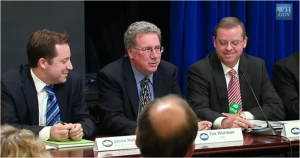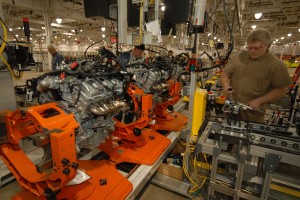We have much more to do and your continued support is needed now more than ever.
Job Creators and Innovators Bring the Auto Turnaround to Life
Highlights from “Advanced Vehicles: Driving Growth”

Panels on economic recovery and innovation brought together manufacturers, educators, and leaders in labor and local economic development and a robust audience of auto sector experts. The event was opened by Administration leaders, and NWF joined White House staff and NRDC as moderators.
Panelists—and not always those you’d expect—communicated the thrill of the technological renaissance underway and the reward of rebuilding jobs and businesses in hard-hit communities. They conveyed a deep commitment to protecting the environment and prosperity for the next generation, and a shared sense that smart fuel-economy standards, investments and partnerships with government and each other mean continued progress.
The full video of Advanced Vehicles: Driving Growth is online (Part 1, Part 2), and look for additional NWF staff thoughts on the event and on the landmark 54.5mpg fuel economy standards due to be finalized this summer here on Wildlife Promise.
To see what’s happening in many more communities who are part of creating the next generation of clean cars and trucks, check out DrivingGrowth.org (NWF is a partner in this new site whose similar name is coincidental).
What is happening in the auto sector today? What does innovation mean to you? What does the future of the auto sector hold? How do we sustain progress? and what does it mean to our future?
Clean cars and trucks are bringing back jobs

Panel speakers talked about bringing this turnaround to life in communities like Toledo, Ohio or Greensburg, Indiana, where Honda is building its new Acura ILX hybrid. “It may seem counterintuitive,” said Vince De Zorzi of Nexteer Automotive which builds fuel saving electric power steering systems, “but during our transformation, we’ve brought back work from Mexico, Brazil and India into Saginaw, Michigan.”
“It wasn’t too many years ago that Toledo in any economic development statistic would have been listed as leading the race to the bottom, now the Brookings Institution will tell you… that we’re helping to lead the recovery…. What we’re seeing right now is … $900M of capital investment in … three facilities alone – one by JCI, one by Chrysler, and one by General Motors with its powertrain plant. These facilities are not only helping to retain about 3800 jobs, and create 1500 new jobs, the products they are producing help further the goals of environmental sustainability and fuel economy.” “We’re also seeing a diversification of our economy. Toledo, building on its tradition as a glass manufacturer, has been one of the leading centers in North America for the solar industry. And just four months ago a European company, Isofoton, came to Napoleon, Ohio where they’re making a $30M investment to build solar panels, and as they ramp up they’ll add 300 jobs.” — Ford Weber, President and CEO, Lucas County Improvement Corporation (LCIC)/Northwest Ohio Regional Economic Development Association
Michael Psaros of KPS Capital Partners, spoke about investments made by private equity, in collaboration with labor, to rebuild businesses making natural gas-powered buses and forgings for high efficiency engines that help meet new fuel economy standards: “the technology is here. America is a leader….These initiatives are to be applauded and we’re investing tens of millions of dollars behind them.”
“We started many years ago as a driveline and hydraulic steering company… As the market and demand for more fuel efficient vehicles moves forward, we’re finding that electric power steering is coming into the market far more rapidly than we thought… Like [others] we also went through some very, very difficult times. We had to transform our business model and we wouldn’t have done it without the partnership with the union, without the sacrifices, vision, and courage… they had. As a result, we’re currently investing over $100 million in…our oldest plant, built in 1953, and converting it into a state of the art electric power steering facility, which over the next few years will supply the majority of full sized pick-up trucks in North America.” —Vince De Zorzi, Senior Vice President Global Manufacturing Operations, Driveline Business Unit, Chief Quality Officer, Nexteer Automotive
Innovation is rebuilding America’s technological leadership
“I was privileged to attend the opening day of the …Detroit auto show this year. What I saw there was breathtaking,” Those comments from CEQ Deputy Director Gary Guzy in the opening panel were echoed by NWF’s Tim Warman, opening the second panel, who reflected that not only does automotive innovation hold one of the keys to addressing the climate challenge, but that “we’re living at a time when you can buy the best cars ever made.”
“The internal combustion engine has been around for 100 plus years, and when you look at the leaps and bounds we’ve made in technology in that time, the internal combustion engine just [hadn’t] kept pace with that. [But] the news now is that it has and it will. I spoke about the EcoBoost engine earlier, we’ll also have a 4-cylinder version of that coming out, and – I’m not at liberty say what – but there’s something after that coming – that…fuel economy-wise and environmentally will be absolutely astounding…and it will be built right in Cleveland.” —Mike Gammella, President of UAW Local 1250, Ford Cleveland Engine plant
Speakers conveyed the excitement and pace of innovation, and provided a glimpse of their particular approaches to transforming “traditional” internal combustion engine technology, and capturing leadership in the next generation of hybrid, electric and other technologies.
“We don’t clearly know what kind of power plant will be powering our vehicles out beyond 2025—will it be advanced internal combustion engines powered by gasoline on ethanol or natural gas, or advanced diesel engines, or will it be electric drive vehicles powered by batteries, or hydrogen fueled electric drive vehicles?… So frankly it’s a very exciting time to be an automotive engineer… The race is on for us to meet the challenges of air quality, climate change and energy security…The future of the auto industry will be determined by retail customers who buy these cars.. so we have to make sure that every product we develop will be better than the one it replaces.” —Ryan Harty, Manager of Environmental Business Development, Honda
“Large companies and governments have a responsibility to adopt a portfolio theory in which they explore many different aspects of how to solve the problem… For a small company like ours that lives and dies by its first and second product, we are very committed to lithium ion batteries and we have to make sure that particular economic and wallet argument works best. We received a 4 million grant from ARPA-E in December 2009, and we developed a world record battery [with an energy density] of 400 Wh/kg. This is a moonshot in the electrochemistry business. …We made automotive grade cells and gave it to the naval surface warface center in Crane, Indiana, and they tested our claims. …. What does this mean for the automotive industry? Well I think good news is on the horizon. A 150-200 mile [per charge, electric] car for $30,000 or less is not too far away ….. We were founded to make a mass market electric vehicle [possible]. —Atul Kapadia, CEO of Envia Systems Inc
“Ive worked in the automotive industry for 33 years, all in the advanced battery area, and clearly this is the most exciting time… ”At our UAW battery plant in Toledo (and we appreciate our partnership with the state of Ohio) we are investing over $100M in establishing a new line for what is called AGM technology. It’s a battery that’s critical to the stop-start technology you’re hearing about. Basically when the vehicle is at at a stop light, the engine shuts off [if its not needed]… the bottom line is that technology allows you to achieve a 5-12% fuel economy enhancement. Now that AGM technology facilitates the advanced electrical capability in the vehicle, but its also a lighter weight battery than the conventional battery it replaces… and the process we use to make this battery uses less energy and emits less CO2.” —Michael Andrew, Director of Government Affairs and External Communications at Johnson Controls, Inc.
Partnerships, standards, investments key
The value of long-term performance-based fuel economy standards in providing a predictable climate for investment, and in building the next generation of competitive technology and jobs was a recurrent theme in the day’s discussions. But participants stressed that government, industry and the public must continue to work together to make advanced energy and transportation a priority if America is to lead in the global economy.

Kapadia concurred, citing the the strong investment by China and South Korea in R&D. He told the story of the U.S. government investment in the Human Genome Project that had generated hundreds of billions in economic activity. “I don’t think that this money we spend on claiming technology leadership is a waste… As a country we just have to make a decision about whether energy is important or not… if we can see the same kind of results on the energy side … I am convinced we won’t be only identifying problems on [the next] panel, we’ll be taking about how many different kinds of electric cars, how many soldiers and… oil dollars have we saved …and… how much have we saved the environment over the next 10-20 years.”
Gammella was frank on the benefits of the auto recovery loans: ”Understand, I work for Ford Motor Company, Ford was fine, we didn’t need a loan, however, if … those auto parts makers [had] gone down with General Motors and Chrysler, we wouldn’t be here having this discussion today, we’d be talking about the auto disaster instead of the auto revitalization.”
Speakers also flagged a variety of consumer incentives including the Cash for Clunkers program as means of helping households more rapidly purchase fuel efficient vehicles – while others stressed that growing family supporting jobs in the manufacturing sector is critical to ensuring a market for the new technologies we manufacture.
Delivering hope, prosperity and healthy world for our children
Innovation isn’t just happening in technology –people and communities are critical. Companies and the union stressed new partnerships between workers and management that are unlocking innovation on the shop floor, while educators talked about new training being implemented to suit a changing industry.
“We need to create a situation where our students are flexible enough to work in this [rapidly innovating] industry… We need to start to do not just short term skills training for specific areas, but for whole careers….
We have to cross over a watershed … Innovation is [not just] something people in universities do… innovation is often day to day activities on a factory floor. The challenge is not just to respond to the employment growth today, but create a structure for the future.” —Dr. Jim Jacobs, President of Macomb Community College in Warren, Michigan
Panelists had an animated debate about ensuring rewarding and family-suppporting jobs, skills and the inspiration to young people – to enable them to build fulfilling careers in the new high tech manufacturing sector. Andrew, from Milwaukee-based Johnson Controls, and Al Ebron, Executive Director of the National Alternative Fuels Training Consortium (NAFTC) West Virginia University in Morgantown, described their respective partnerships at the high school level, while others spoke personally about the importance of communicating the changes in the manufacturing sector and reviving enthusiasm in making things.
States and cities are playing a role in education and outreach as well. Jules Toraya, Program Manager at the Center for Transportation and the Environment (CTE), Clean Cities-Atlanta, City of Atlanta, talked about what is happening in in the Southeast to help deploy electric vehicle and alternative fuel technologies, and his own epiphany while in Iraq on the importance of energy independence and clean energy jobs for veterans. And he gave a shout out to young entrepreneurs, citing a new electric skateboard manufacturer: “For the younger generation, we have to demonstrate and make our own value—and we are doing that.”
Gammella took a more sober view, but ended on a similar note: “There are a whole lot of people out there that don’t have much hope… We have kids graduating from college who can’t find a job …we’ve got to give these young people hope…WE have to bring it back … we have to manufacture here we have to be the high tech technology leader here. That’s what America’s all about.”

“Our goal should be to have mobility while preserving the natural world; I think we can meet that goal,” said NRDC Senior Vehicles Analyst Luke Tonachel. Harty, of Honda, spoke about Honda engineers’ commitment to “blue skies for our children”, while Gamella, underscoring the importance of fuel efficient vehicles, said: “Bottom line is this, we all breathe the same air, we all live in the same world, we have to protect the environment first and foremost, and one the biggest ways to do that is we have to get off our dependency on foreign oil. And we can do that …in this country.”
UAW Vice President, Cindy Estrada summed it up in speaking about her two children, and the potential to build prosperity, good jobs, and healthy environment at once: “I think we’re going to get there… its not an option not get there, I want [my two kids] to be in that kind of world.”
(Credit: wh.gov for Photos of Weber, Dezorzi, Andrew, Jacobs, Estrada as well as Photos of Gamella, Kapadia, Harty, Warman et al.)





















